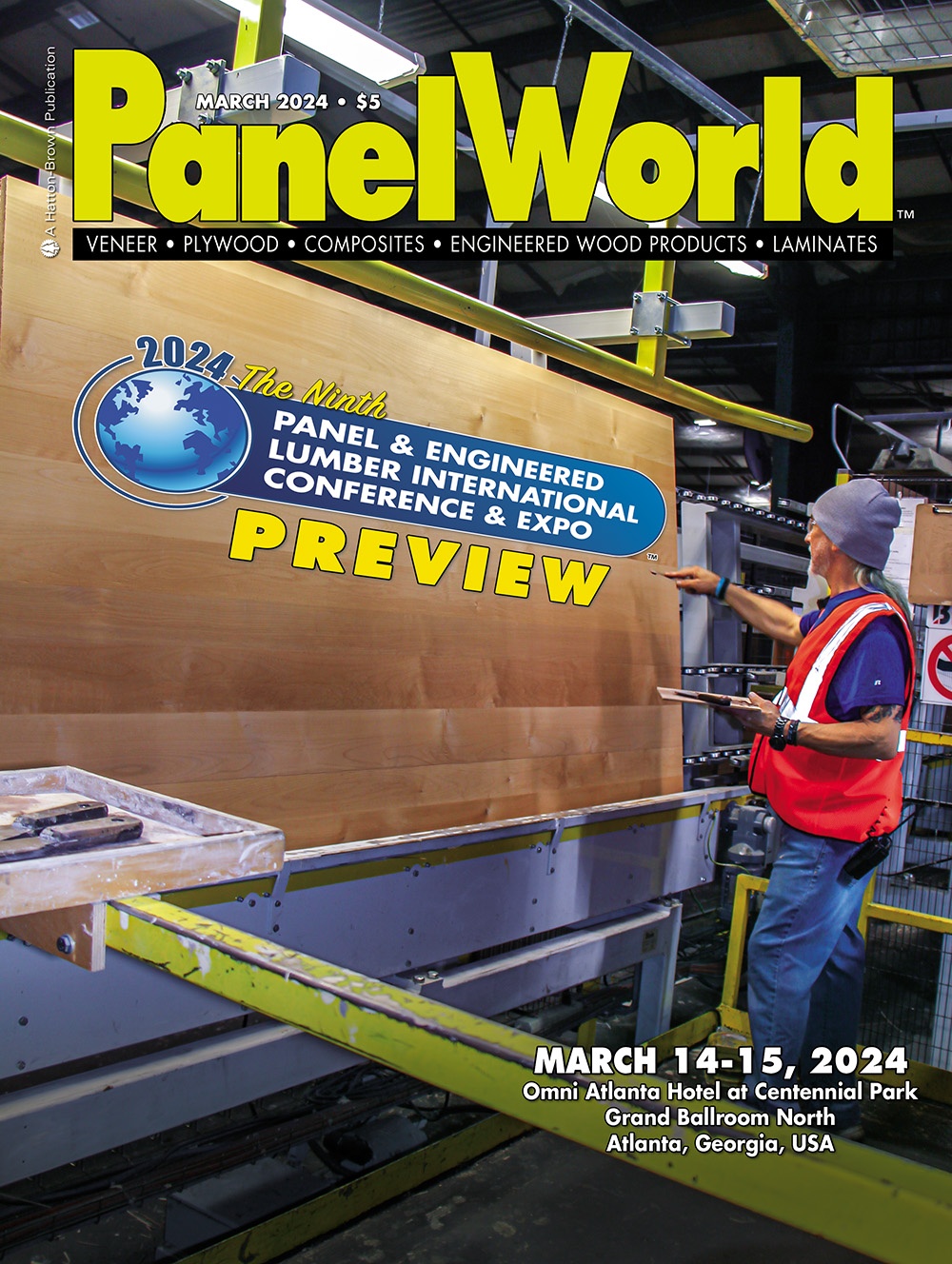March 2024
Cover: The Ninth Annual Panel & Engineered Lumber International Conference & Expo Preview
Has it been two years already? Apparently so, as the ninth Panel & Engineered Lumber International Conference & Expo (PELICE) comes back to life March 14-15 in Atlanta.
Inside This Issue
PELICE 2024 Preview
Covering both the structural and non-structural panel industries, the event is set for March 14-15 in Atlanta.
SUBSCRIBE TO PANEL WORLD TODAY TO GET YOUR COPY OF THE ANNUAL DIRECTORY & BUYERS’ GUIDE
UPDATE
- Hampton Lumber Purchases Rebuilt
- Boise Announces New Investments
PROJECTS
- Automated PRS Boosts Kalispell
- Hunt Modernizes Lathe Operations
- Glulam Project Names ERP Provider
SUPPLY LINES
- Pankoke Directed Hymmen Growth
- Siempelkamp Deals With Sunds Fibertech
- Hoffman Played Key Role
- Lander Takes Over As CFO
CLIPPINGS
- Roseburg Names Ramm Senior VP
- Oenning Steps Into New Role
- Blackburn Named VP-Operations
Find Us On Social
Forest Products Industry Says Goodbye To Walter
Article by Rich Donnell, Editor-in-Chief, Panel World
Walter Jarck, whose career in the forest products industry spanned 65 years and ranged from logging machinery to engineered wood products, died January 3, surrounded by his children, in North Wilkesboro, NC. He was 92.
Jarck spent the last two decades of his life trying build a high scale, commercial production TimTek (formerly Scrimber) composite lumber manufacturing facility, and nearly pulled it off; but long before then as a forest engineer he was a pioneer innovator of pulpwood loading and forwarding machinery, and log harvesting and processing machinery.
Jarck was born on May 7, 1931 in Queens, New York, and learned a hard work ethic from his immigrant parents. It was when he moved with his mother to the Catskill Mountains of New York that he fell in love with the woodlands.
He graduated in 1953 from the New York College of Forestry at Syracuse and entered Naval Officer Candidate School. He became a destroyer officer and ultimately retired from the Naval Reserves as a Captain. He recalled while in the Navy working with ships and mechanical, propulsion, steam and hydraulic systems.
Upon leaving the Navy he went to work for Caterpillar Tractor Co. as a logging engineer and spent a year in their sales training program and experienced the welding, mechanical and engine shops and was involved in the development of root rakes. “By the time I left I knew how a scraper was built, how a bulldozer was built, so I was really turned on by that,” Jarck said.
In 1958 he moved to the South and went to work as a forest engineer for Bowater, which was building a paper mill in Catawba, SC. “My boss said, ‘we have a six hundred million dollar paper mill being built and we’re going to be relying on the sweat of a few laborers to hand load and to bring wood in. There’s got to be a better way.’”
While Jarck was supervising the construction of buildings and wood yards for the new mill, he started looking at ways to mechanize logging equipment, which would alleviate the traditional practice of mills having to stockpile six months of logs in their wood yards to overcome the winter weather.
In the early 1960s Jarck led the development of the Go Getter pulpwood forwarder and in the mid 1970s working with Charles Allen the Allen Jarck Harvester for felling pulpwood and processing it into sticks, an early version of today’s cut-to-length machinery.
In 1982 Jarck joined Georgia-Pacific as assistant vice president and senior forester. He was involved in policy making and in several acquisitions. He retired in 1996 from Georgia-Pacific as corporate director of forest resources and then taught industrial forestry courses at the University of Georgia for several years.
Jarck was far from retired. In 2001 he and partner Geoff Sanderson acquired the world rights to the Scrimber technology from the Australia government interests that invented it in the mid 1970s. Scrimber was produced from small plantation trees to form a reconsolidated wood product with uniform properties comparable to sawn timber.
Jarck and Sanderson formed TimTek (they didn’t purchase the Scrimber name) and their newly formed company purchased the pilot plant in Australia and relocated it to the campus of Mississippi State University.
They wanted to build a true scale plant that would produce a product up to 48 in. in width, up to 6 in. in thickness and almost any length. TimTek beams, they said, would compete favorably in the large sizes for trusses, garage door headers, joists, rimboards and long-span structural timbers.
Jarck wrote: “Our process can best be summarized by crushing the debarked small diameter stems in a scrimming mill, then drying the scrim or mat of fibers, adding adhesives, collating the mats, steam pressing, then cutting to size and finishing. The resource can be softwood or hardwood in the 4-8 in. diameter classes. Resources of this nature are available at delivered prices that are one-fourth or one-fifth the cost of resources purchased in the sawtimber or veneer log categories.”
Want More Content?
Panel World is delivered six times per year to North American and international professionals, who represent primary panel production operations. Subscriptions are FREE to qualified individuals.
Newsletter
The monthly Panel World Industry Newsletter reaches over 3,000 who represent primary panel production operations.
Subscribe/Renew
Panel World is delivered six times per year to North American and international professionals, who represent primary panel production operations. Subscriptions are FREE to qualified individuals.
Advertise
Complete the online form so we can direct you to the appropriate Sales Representative. Contact us today!

